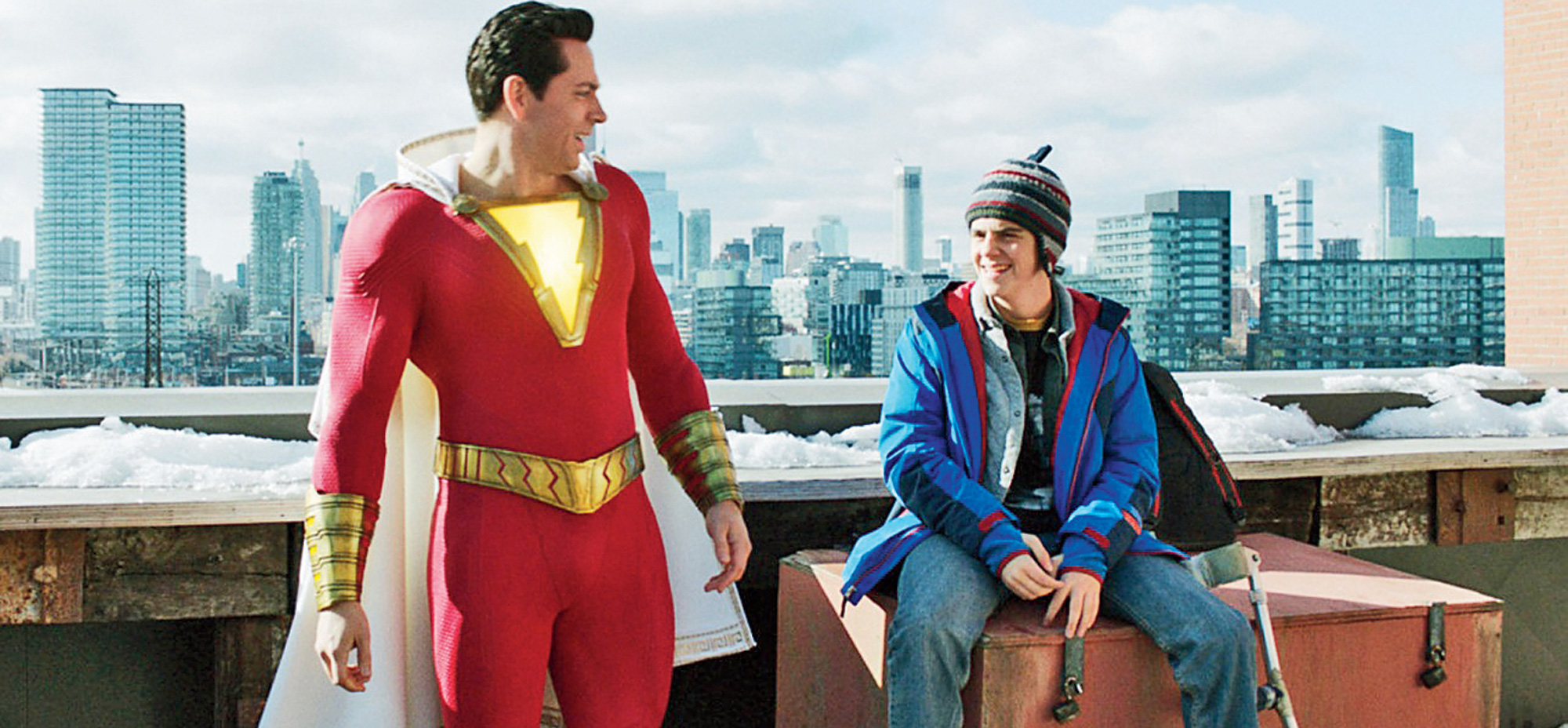Ever since Christopher Nolan took Batman to their mutually productive dark place, the DC cinematic super-universe has been as sombre as a grave. There have been exceptions, shimmers of light amid the doom. Outside the animated realm, though, the stories and mood have been downbeat, matched by hues that range from drab to black amid bilious green, raging purple and watery blue. Even the “S” on Superman’s chest looks drained of cheer, more like dried blood than some candy-coloured delight.
Given this, the bright, popping red of the superhero costume in Shazam! is an early warning sign, as obvious as a matador’s cape, that the dreary and crepuscular have given way to something less self-serious and end-of-the-world grim. It’s a nice change of pace for a big-screen mega-comic, if not a revolutionary shift. There are still a lot of brand shilling and the usual tediously overextended fights, ka-pow and ka-boom. But these are delivered via Shazam, a charmingly breezy avenger in tights once known as Captain Marvel, aka the World’s Mightiest Mortal, or as I thought of him going in: Who?
The answer emerges piecemeal in Shazam!, another movie about a superhero with dual-identity issues. Here, the divided self begins with Billy (Asher Angel, a relaxed, natural presence), a foundling with pluck, heart and a sob story. He’s on a mission to find his mother (longish story), a journey that — as sometimes happens in male quests — leads him to a surrogate father. This one is an ancient wizard called, ta-da, Wizard (Djimon Hounsou in a comic Halloween-ish get-up), who passes his magic to Billy. Once back in his normal realm, Billy discovers that he can tap great powers by saying the word “shazam”, which turns him into a hero with an adult body (Zachary Levi).
If this sounds familiar — the Moses-like saviour who learns he’s meant for greatness — it’s because the character was conceived to compete with Superman. Yet because Shazam isn’t as well known as Supes et al., he’s not as weighed down with fan expectations, the fate of the world and auteurist aspirations. The filmmakers (Henry Gayden wrote the script, David F. Sandberg directed) adhere to the heroic template, which means there’s a regulation villain (the reliably watchable Mark Strong) with schemes. But they also fill in the faces and places, and add enough shading and colour to Billy’s world that when his inevitable fight against evil happens it feels as if something more than the box office is at stake.
Of course, a franchise may be at stake, though considering how often the movie name-drops Batman and Superman, it can’t help but feel as if the entire DC movie world is on the line. And maybe Shazam is a risk, just because he’s an unfamiliar avenger in a wildly overcrowded field. Created in 1939 and originally called Captain Marvel (and physically modelled on the actor Fred MacMurray), this one was a hit and earned fans like Elvis Presley, who apparently borrowed his forelock and lightning bolt from the comic. But for legal reasons, Captain Marvel went into storage only to be later resurrected by DC as Shazam. (DC’s long-time foe, Marvel Comics, managed to trademark the character’s first name for the avenger currently played by Brie Larson in Captain Marvel.)
The new movie quickly dusts off the Shazam story, first by grounding it in Billy, a sweet, if somewhat melancholic mischief-maker who soon becomes an appealing protagonist. The opening scene involving a couple of dimwit cops feels as ancient as a Bowery Boys movie, perhaps intentionally. Things soon settle into an easy, everyday groove when Billy moves into a new foster home, a sprawl populated by kids (Jack Dylan Grazer, among them) who are generally cute instead of cutesy. Tenderly overseen by Rosa and Victor (Marta Milans and Cooper Andrews), the house has a lived-in cosiness, a warmth and security that feels as unforced as the mix of ethnicities and races.
Once Billy says that magic word and his supersized alter ego appears, the movie goes to its happy place and comfortably embraces its own identity as a light, jocular, modest entertainment. Levi is best known for his television roles (Chuck, The Marvelous Mrs. Maisel), but he easily scales up for the big screen. He can look like a beefier, tougher John Krasinski; as Shazam, though, Levi is pure cartoon, from his bootblacked helmet of hair to his tumescent musculature. Ken-doll plastic and handsome, he is an ideal, suitably absurd figure on which to hang an old-fashioned hero with a satiny high-collared cape and a fat yellow arrow suggestively pointing down.
The arrow is a winking joke and as subtle as the nod to the Tom Hanks body-swapping comedy Big. It’s also a reminder of Billy’s larger human journey, a metamorphosis that remains humorously, identifiably awkward, even as he wills his inner super-adult to heroic life. Angel’s performance lays the groundwork for the character — and keeps him tethered to reality — while Levi lifts Shazam up with an exuberant turn that conveys the delight of Billy’s extreme transformation as well as its lingering adolescent ungainliness and excess. It’s one thing to fight evil, but Shazam’s eye-popping, slack-jawed, discordant physicality is a reminder that it’s just as tough to get a grip on yourself.











